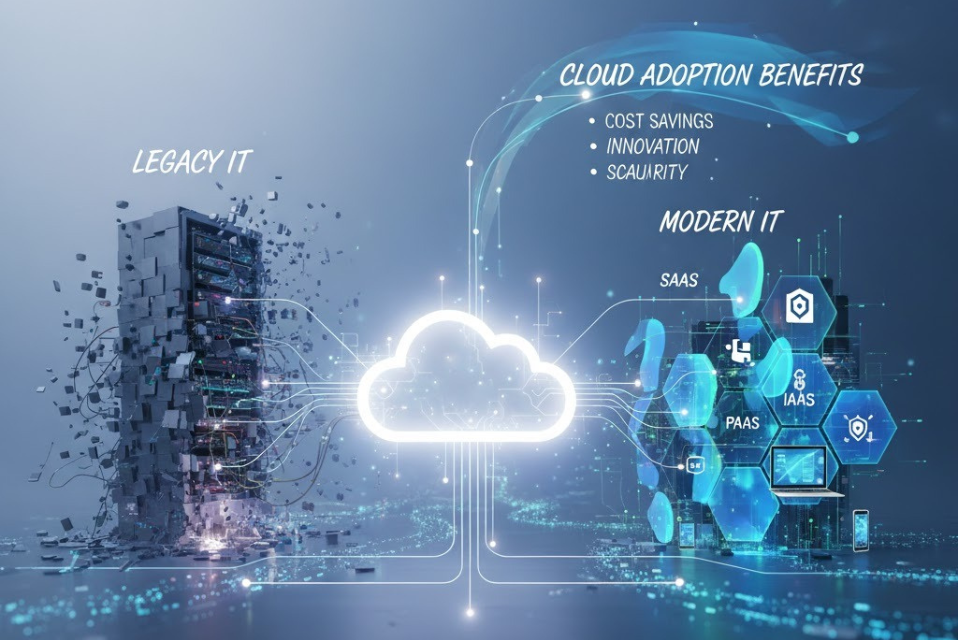Introduction
Cloud computing is often discussed as a technology, but its impact is fundamentally strategic. It is more than just outsourcing servers; it is the complete re-architecture of how modern businesses consume, manage, and scale their technology resources. The shift to the cloud marks the end of the traditional, monolithic IT structure and ushers in the Cloud Era, where agility and intelligence are paramount.
This transformation—the journey from owning physical assets to consuming resources as a service—is redefining every facet of the modern IT department, from infrastructure to innovation.
The Economic Imperative: Why the Cloud Dominates
The sheer scale and growth of the cloud market underscore its necessity for modern business survival. Organizations are no longer asking if they should adopt the cloud, but how fast.
- Massive Market Growth: The global cloud computing market size is projected to exceed $1.5 trillion by 2030, according to Grand View Research (Grand View Research, 2023). This immense figure confirms that cloud adoption is not a trend, but the default computational backbone of the global economy.
- The Cost-Benefit Shift: The shift to OpEx (Operational Expenditure) from CapEx (Capital Expenditure) fundamentally changes the finance-IT relationship. Instead of massive, upfront investments in physical hardware, companies pay only for the resources they actually use. This model allows for unprecedented financial agility.
1. Transforming Infrastructure: From Static to Elastic
The most visible transformation is in infrastructure management. Cloud computing dismantles the rigidity of the traditional data center.
- Unprecedented Scalability and Elasticity: In the traditional model, scaling required months of planning, purchasing, and installation. Cloud allows IT teams to instantly provision or decommission resources—servers, storage, and databases—in minutes. This elasticity is essential for handling unpredictable traffic spikes, like major retail events or high-demand software launches.
- Decentralized Operations: Cloud platforms facilitate hybrid and multi-cloud strategies, allowing organizations to select the best environment (public, private, or multiple providers) for different workloads based on cost, performance, and compliance requirements.
2. Accelerating Development and Innovation
The cloud has revolutionized the software development lifecycle (SDLC), making development faster, more collaborative, and less prone to environment-specific errors.
- DevOps and CI/CD Enablement: Cloud-native tools and managed services (like serverless functions, managed containers, and API gateways) eliminate the need for developers to manage underlying infrastructure. This allows for rapid Continuous Integration/Continuous Deployment (CI/CD) pipelines. Teams can deploy code multiple times a day, instead of once a quarter.
- Focus on Value, Not Maintenance: By offloading commodity tasks (like patching operating systems or managing hardware redundancy) to cloud providers, IT staff can redirect their focus toward high-value, differentiating activities, such as product innovation and security architecture.
3. Redefining Security and Compliance
While many organizations initially hesitated due to security concerns, the reality is that major cloud providers often offer a superior security posture than most private data centers.
- The Shared Responsibility Model: The cloud operates on a Shared Responsibility Model, where the provider manages the security of the cloud (physical security, infrastructure hardware), and the customer manages security in the cloud (data, access management, operating system configuration).
- Built-in Advanced Security: Cloud platforms offer built-in services for identity management, network monitoring, threat detection, and automated compliance checks that are continuously updated by specialized teams. For many businesses, accessing enterprise-grade security tools via the cloud is the only financially viable option.
The Four Pillars of Cloud Transformation
| Pillar | IT Transformation | Primary Business Benefit |
|---|---|---|
| Agility | Instant resource provisioning and release. | Faster time-to-market for new products and services. |
| Cost Efficiency | Shift from CapEx to OpEx (pay-as-you-go). | Reduced total cost of ownership (TCO) and greater financial flexibility. |
| Innovation | Use of managed services (Serverless, PaaS). | Engineers focus on core business logic, not infrastructure maintenance. |
| Global Reach | Deploy applications in multiple regions instantly. | Seamlessly expand market presence and improve customer latency globally. |
Conclusion: The New Baseline for IT
Cloud computing is no longer a strategic choice—it is the baseline requirement for modern competitive operation. It transforms the IT department from a keeper of physical assets into an agile, strategic broker of services.
Navigating the Cloud Era successfully means embracing this fundamental transformation: leveraging elasticity for scale, using managed services for speed, and building security and compliance directly into cloud architecture. The enterprises that fully commit to this model are the ones that will define the efficiency and innovation standards of the future.







